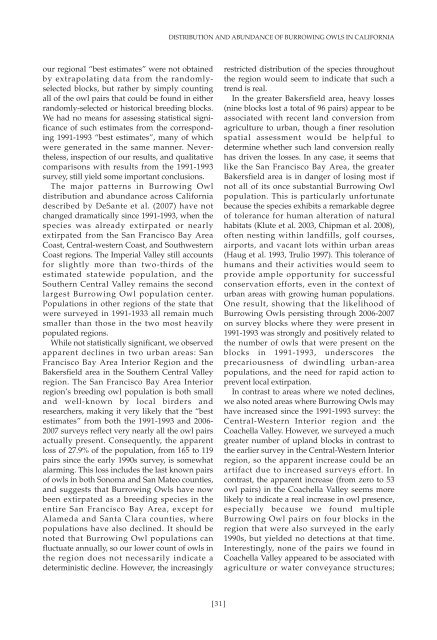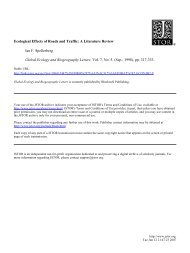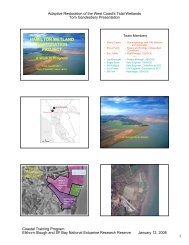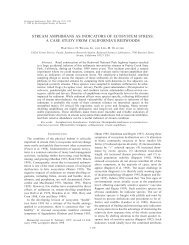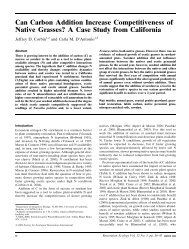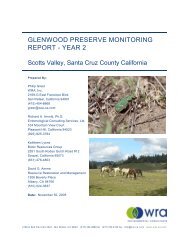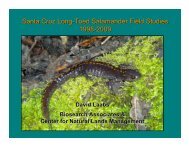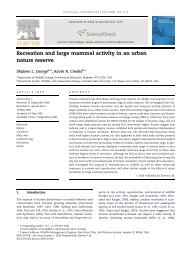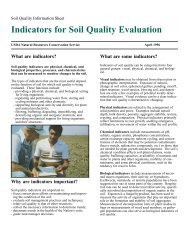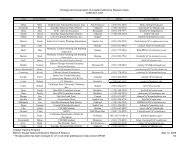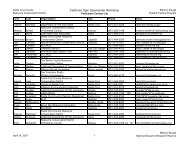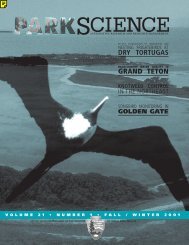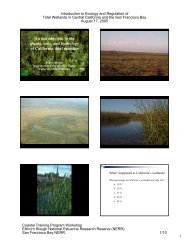BIRD POPULATIONS - Birdpop.org
BIRD POPULATIONS - Birdpop.org
BIRD POPULATIONS - Birdpop.org
- No tags were found...
Create successful ePaper yourself
Turn your PDF publications into a flip-book with our unique Google optimized e-Paper software.
DISTRIBUTION AND ABUNDANCE OF BURROWING OWLS IN CALIFORNIAour regional “best estimates” were not obtainedby extrapolating data from the randomlyselectedblocks, but rather by simply countingall of the owl pairs that could be found in eitherrandomly-selected or historical breeding blocks.We had no means for assessing statistical significanceof such estimates from the corresponding1991-1993 “best estimates”, many of whichwere generated in the same manner. Nevertheless,inspection of our results, and qualitativecomparisons with results from the 1991-1993survey, still yield some important conclusions.The major patterns in Burrowing Owldistribution and abundance across Californiadescribed by DeSante et al. (2007) have notchanged dramatically since 1991-1993, when thespecies was already extirpated or nearlyextirpated from the San Francisco Bay AreaCoast, Central-western Coast, and SouthwesternCoast regions. The Imperial Valley still accountsfor slightly more than two-thirds of theestimated statewide population, and theSouthern Central Valley remains the secondlargest Burrowing Owl population center.Populations in other regions of the state thatwere surveyed in 1991-1933 all remain muchsmaller than those in the two most heavilypopulated regions.While not statistically significant, we observedapparent declines in two urban areas: SanFrancisco Bay Area Interior Region and theBakersfield area in the Southern Central Valleyregion. The San Francisco Bay Area Interiorregion’s breeding owl population is both smalland well-known by local birders andresearchers, making it very likely that the “bestestimates” from both the 1991-1993 and 2006-2007 surveys reflect very nearly all the owl pairsactually present. Consequently, the apparentloss of 27.9% of the population, from 165 to 119pairs since the early 1990s survey, is somewhatalarming. This loss includes the last known pairsof owls in both Sonoma and San Mateo counties,and suggests that Burrowing Owls have nowbeen extirpated as a breeding species in theentire San Francisco Bay Area, except forAlameda and Santa Clara counties, wherepopulations have also declined. It should benoted that Burrowing Owl populations canfluctuate annually, so our lower count of owls inthe region does not necessarily indicate adeterministic decline. However, the increasinglyrestricted distribution of the species throughoutthe region would seem to indicate that such atrend is real.In the greater Bakersfield area, heavy losses(nine blocks lost a total of 96 pairs) appear to beassociated with recent land conversion fromagriculture to urban, though a finer resolutionspatial assessment would be helpful todetermine whether such land conversion reallyhas driven the losses. In any case, it seems thatlike the San Francisco Bay Area, the greaterBakersfield area is in danger of losing most ifnot all of its once substantial Burrowing Owlpopulation. This is particularly unfortunatebecause the species exhibits a remarkable degreeof tolerance for human alteration of naturalhabitats (Klute et al. 2003, Chipman et al. 2008),often nesting within landfills, golf courses,airports, and vacant lots within urban areas(Haug et al. 1993, Trulio 1997). This tolerance ofhumans and their activities would seem toprovide ample opportunity for successfulconservation efforts, even in the context ofurban areas with growing human populations.One result, showing that the likelihood ofBurrowing Owls persisting through 2006-2007on survey blocks where they were present in1991-1993 was strongly and positively related tothe number of owls that were present on theblocks in 1991-1993, underscores theprecariousness of dwindling urban-areapopulations, and the need for rapid action toprevent local extirpation.In contrast to areas where we noted declines,we also noted areas where Burrowing Owls mayhave increased since the 1991-1993 survey: theCentral-Western Interior region and theCoachella Valley. However, we surveyed a muchgreater number of upland blocks in contrast tothe earlier survey in the Central-Western Interiorregion, so the apparent increase could be anartifact due to increased surveys effort. Incontrast, the apparent increase (from zero to 53owl pairs) in the Coachella Valley seems morelikely to indicate a real increase in owl presence,especially because we found multipleBurrowing Owl pairs on four blocks in theregion that were also surveyed in the early1990s, but yielded no detections at that time.Interestingly, none of the pairs we found inCoachella Valley appeared to be associated withagriculture or water conveyance structures;[31]


